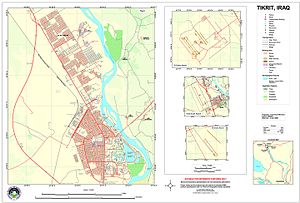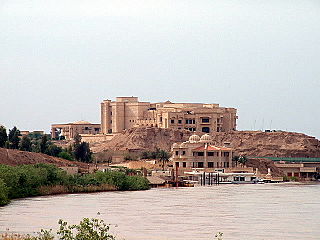
Tikrit is a city in Iraq, located 140 kilometers (87 mi) northwest of Baghdad and 220 kilometers (140 mi) southeast of Mosul on the Tigris River. It is the administrative center of the Saladin Governorate. As of 2012, it had a population of approximately 160,000.

Baiji is a city of about 173,677 inhabitants in Salah ad Din governorate in northern Iraq. It is located some 130 miles north of Baghdad, on the main road to Mosul. It is a major industrial centre best known for its oil refinery, the biggest in Iraq, and has a large power plant. With regards to transport in the area, Baiji is a junction of the national railway network.

Majid al Tamimi Airbase, officially known as the Tikrit Air Academy and formerly as Al Sahra Airfield is an air installation near Tikrit in northern Iraq. The installation is approximately 170 kilometers north of Baghdad and 11 kilometers west of the Tigris River. Prior to 2003, Al Sahra Airfield was the main base of the Iraqi Air Force Air Academy. The Marines from Task Force Tripoli captured the base from the Iraqi Army during the 2003 U.S. invasion of Iraq and turned it over to the United States Army who used it as the headquarters of the United States Division–North. The airfield is served by two main runways measuring 9,600 feet (2,900 m) long with a shorter runway measuring 7,200-foot (2,200 m). The Americans named the airfield after Captain Michael Scott Speicher, a United States Navy pilot who was killed in action in Iraq during the Gulf War.

Beginning in December 2012, Sunnis in Iraq protested against the Maliki government. On 28 December 2013, a Sunni MP named Ahmed al-Alwani was arrested in a raid on his home in Ramadi. Alwani was a prominent supporter of the anti-government protests. This incident led to violence in Al Anbar Governorate between the Iraqi Army and a loose alliance of tribal militias and other groups fighting alongside the Islamic State of Iraq and the Levant (ISIL).
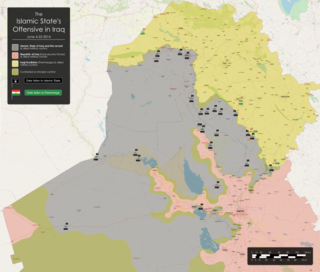
The Northern Iraq offensive began on 4 June 2014, when the Islamic State of Iraq and Levant, assisted by various insurgent groups in the region, began a major offensive from its territory in Syria into Iraq against Iraqi and Kurdish forces, following earlier clashes that had begun in December 2013 involving guerillas.
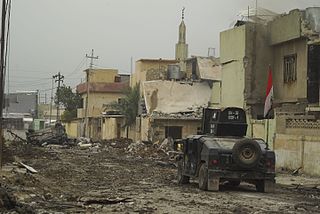
The War in Iraq was an armed conflict between Iraq and its allies and the Islamic State. Following December 2013, the insurgency escalated into full-scale guerrilla warfare following clashes in the cities of Ramadi and Fallujah in parts of western Iraq, and culminated in the Islamic State offensive into Iraq in June 2014, which lead to the capture of the cities of Mosul, Tikrit and other cities in western and northern Iraq by the Islamic State. Between 4–9 June 2014, the city of Mosul was attacked and later fell; following this, Prime Minister Nuri al-Maliki called for a national state of emergency on 10 June. However, despite the security crisis, Iraq's parliament did not allow Maliki to declare a state of emergency; many legislators boycotted the session because they opposed expanding the prime minister's powers. Ali Ghaidan, a former military commander in Mosul, accused al-Maliki of being the one who issued the order to withdraw from the city of Mosul. At its height, ISIL held 56,000 square kilometers of Iraqi territory, containing 4.5 million citizens.

The departure of US troops from Iraq in 2011 ended the period of occupation that had begun with the U.S.-led invasion in March 2003. The time since U.S. withdrawal has been marked by a renewed Iraqi insurgency and by a spillover of the Syrian civil war into Iraq. By 2013, the insurgency escalated into a renewed war, the central government of Iraq being opposed by ISIL and various factions, primarily radical Sunni forces during the early phase of the conflict. The war ended in 2017 with an Iraqi government and allied victory, however ISIL continues a low-intensity insurgency in remote parts of the country.
Between 1 and 15 August 2014, the Islamic State of Iraq and the Levant (ISIL) expanded territory in northern Iraq under their control. In the region north and west from Mosul, the Islamic State conquered Zumar, Sinjar, Wana, Mosul Dam, Qaraqosh, Tel Keppe, Batnaya and Kocho, and in the region south and east of Mosul the towns Bakhdida, Karamlish, Bartella and Makhmour
The following lists events that happened during 2014 in Iraq.
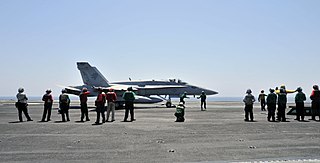
On 15 June 2014, U.S. President Barack Obama ordered United States forces to be dispatched in response to the Northern Iraq offensive of the Islamic State (IS) as part of Operation Inherent Resolve. At the invitation of the Iraqi government, American troops went to assess Iraqi forces and the threat posed by ISIL.

The Iranian intervention in Iraq has its roots in the post-2003 invasion of Iraq by the United States and its allies, when the infrastructure of the Iraqi armed forces, as well as intelligence, were disbanded in a process called "de-Ba'athification" which allowed militias with close ties to Tehran to join the newly reconstituted army.

The Battle of Baiji took place in Baiji, Iraq, lasting from late October 2014 to late October 2015. In mid-November 2014, Iraqi forces retook the city of Baiji, and re-entered the Baiji Oil Refinery. However, fighting continued in the region, and on 21 December 2014, ISIL forces took Baiji and put the Baiji oil refinery under siege once again, before Iraqi forces recaptured the city on 22 October. It gave Iraqi forces complete control of the highway stretching from Baghdad to Baiji, and allowed Iraqi forces to use Baiji as a base for launching a future assault on Mosul.
The Battle of Ramadi, also called the Fall of Ramadi, was part of an ISIL offensive to capture all of the Anbar Province. Ramadi was one of the Iraqi government's last strongholds in Anbar, after ISIL's success in a previous campaign. The battle began in November 2014, and drew to a close on 14 May 2015, as Islamic State of Iraq and the Levant (ISIL) insurgents seized hold of government buildings. On 17 May, the Iraqi Army and special forces fled the city, with 500 civilians and security personnel dead.
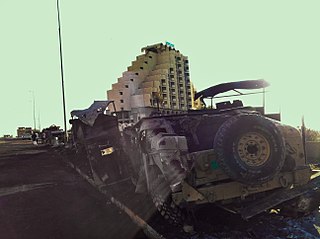
The fall of Mosul occurred between 4 and 10 June 2014, when Islamic State (IS) insurgents, initially led by Abu Abdulrahman al-Bilawi, captured Mosul from the Iraqi Army, led by Lieutenant General Mahdi Al-Gharrawi.

The Second Battle of Tikrit was a battle in which Iraqi Security Forces recaptured the city of Tikrit from the Islamic State of Iraq and the Levant (ISIL). Iraqi forces consisted of the Iraqi Army and the Popular Mobilization Forces, receiving assistance from Iran's Quds Force officers on the ground, and air support from the American, British, and French air forces.
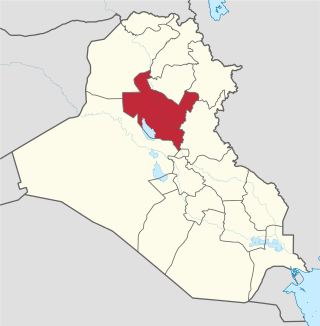
The Salahuddin Campaign was a military conflict in the Saladin Governorate, located in north-central Iraq, involving various factions fighting against a single common enemy, the Islamic State of Iraq and the Levant. The province exited Iraqi government control during ISIL's Northern Iraq offensive when large swathes of the north of the country were captured by the militant group with the Iraqi national army quickly disintegrating in the path of its advance. In light of the sweeping gains of the militants, Nouri Al-Maliki, the Prime Minister of Iraq at that time, attempted to declare a state of emergency though the Iraqi Parliament blocked his efforts to do so.
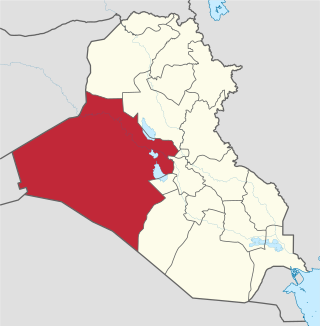
The Al-Karmah offensive, codenamed Fajr al-Karma, was an offensive launched by the Iraqi Army and anti-ISIL Sunni tribal fighters to recapture the Al-Karmah district taken by the Islamic State of Iraq and the Levant in Iraq. The offensive began on 14 April 2015. During the offensive the anti-ISIL forces captured part of the city of Al-Karmah, and the old road of Al-Karmah.

The Timeline of the War in Iraq covers the War in Iraq, a war which erupted that lasted in Iraq from 2013 to 2017, during the first year of armed conflict.
In early 2014, the jihadist group Islamic State of Iraq and the Levant captured extensive territory in Western Iraq in the Anbar campaign, while counter-offensives against it were mounted in Syria. Raqqa in Syria became its headquarters. The Wall Street Journal estimated that eight million people lived under its control in the two countries.
The origins of the Islamic State group can be traced back to three main organizations. Earliest of these was the "Jamāʻat al-Tawḥīd wa-al-Jihād" organization, founded by the Jihadist leader Abu Mus'ab al-Zarqawi in Jordan in 1999. The other two predecessor organizations emerged during the Iraqi insurgency against the U.S. occupation forces. These included the "Jaish al-Ta'ifa al-Mansurah" group founded by Abu Omar al-Baghdadi in 2004 and the "Jaysh Ahl al-Sunnah wa’l-Jama’ah" group founded by Abu Bakr al-Baghdadi and his associates in the same year.


